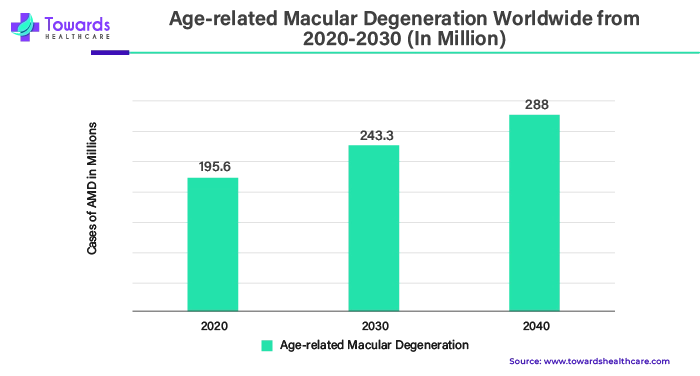April 2025

The global retinal biologics market size is anticipated to grow from USD 27 billion in 2025 to USD 53.61 billion by 2034, with a compound annual growth rate (CAGR) of 7.92% during the forecast period from 2025 to 2034.

The retinal biologics market is dominated by therapeutic drugs for the retina, which are used to treat conditions including diabetic retinopathy and age-related macular degeneration. Growth factors, vaccinations, immunological modulators, human blood and plasma products, and monoclonal antibodies are examples of biologics. A large class of medications produced by biotechnology from people, animals, or microbes are known as biologic drugs. Vaccines, blood, blood components, cells, allergies, genes, tissues, and recombinant proteins are only a few of the numerous varieties of biological medications. Retinal problems have been among the many therapeutic fields in which biological therapies have changed disease treatment. In addition, the results of treating neovascular retinal illnesses have improved dramatically with the use of biological treatments, which promotes the market’s growth.

Diabetes-related retinopathy (DR) is a secondary condition that affects the eyes of diabetics due to high blood sugar levels. One of the most prevalent vision-related conditions, diabetic retinopathy, is becoming more and more prevalent as the number of people with diabetes rises daily. Globally, diabetes is becoming more common owing to a combination of factors, including heredity, eating disorders, physical inactivity, and bad eating habits. DR is a significant microvascular end-organ consequence of diabetes that affects 30% to 40% of all diabetics. There is a definite correlation between the growth in diabetes prevalence and the occurrence of DR.
For instance,
Because biologics are extremely sophisticated drugs, their cost is significant. This indicates that compared to other treatments, the processes involved in research, development, manufacture, testing, and approval are more challenging and time-consuming. They have around 25,000 atoms in them. In contrast, aspirin is a medicine that has 21 atoms in it. Furthermore, in order to generate the finished pharmaceutical product, scientists must cultivate, replicate, extract, and purify the chemicals in a lab because they are derived from living things. This implies that biological batches are not all the same. Manufacturers have to make sure that every batch operates uniformly and has a consistent impact on every patient, which increases complexity and expenses. The cost of creating and producing novel therapeutic and biological medications can approach $1.1 billion.
The phrase "personalized medicine" refers to a broad range of techniques that are used to customize healthcare to meet the requirements of specific individuals. It may result in less need for trial-and-error methods and may prevent the need for needless therapies, which might lead to more successful treatments for ophthalmology patients. Additionally, healthcare systems may save money as a result of this. It's crucial to use diagnostic methods that enable thorough individual evaluation. Among the methods employed are translational research and next-generation sequencing. Trials for gene therapy-based treatments for ocular conditions such as age-related macular degeneration and retinitis pigmentosa have been presented. The field of ophthalmic research has recently seen a rise in the discussion of wearable technologies and machine learning due to the rapid growth of artificial intelligence and multidisciplinary collaboration. It is possible that novel approaches to customized ophthalmology may emerge.
By drug class, the VEGF-A antagonist segment dominated the retinal biologics market in 2023. For the past ten years, VEGF-A monotherapy has been the cornerstone of treatment for retinal neovascular disorders. For retinal illnesses, bevacizumab (IVB), ranibizumab (IVR), aflibercept (IVA), brolucizumab (IVBr), and faricimab are among the available intravitreal anti-VEGF medicines. The most recently licensed bispecific antibody, faricimab, targets VEGF-A and angiopoietin-2 (Ang-2) exclusively among these treatments. It has been demonstrated that these medications can lessen vascular leakage and proliferation and enhance eyesight in anywhere between 50 and 95 percent of cases.
| VEGF-A Antagonist Drugs | Leakage Reduction and Vision Restoration (In %) |
| Aflibercept | 79-83% |
| Ranibizumab | 61-75% |
| Bevacizumab | 59-68% |

By indication, the macular degeneration segment accounted for the largest retinal biologics market share in 2023. An increase in cataract cases has been predicted as a result of an aging population, particularly in individuals over 70. In addition, alterations in their way of life and exposure to outside elements (such as winds, low humidity, and air pollution) could raise the proportion of individuals experiencing symptoms of dry eyes or ocular irritation. Reducing the worldwide burden of eye disorders requires a high level of public awareness of prevalent eye diseases. A major advancement in the creation of biologics for the treatment of ocular neovascular disorders is anti-VEGF therapy.
For instance,
By distribution channel, the hospital pharmacies segment held the largest share of the retinal biologics market in 2023. One of the most important hospital departments that handles the manufacture, testing, packing, distribution, compounding, storage, and dispensing of medications is the pharmacy. Hospital pharmacy significantly affects how much healthcare expenditures cost. In today's hospital pharmacy, drug information and monitoring services are combined.
Medication purchases, storage, handling, pricing, and dispensing are all within the competency of the hospital pharmacist. In addition, pharmacists serve as liaisons between the patient and the doctor by giving medication information to the general public and other healthcare professionals. Specifications for buying pharmaceuticals, chemical, and biological medicines, etc., are provided by hospital pharmacists. Hospital pharmacists also assist with hospital research programs and provide drug monitoring services for inpatients.
North America dominated the retinal biologics market in 2023. The region is known for its technological advancements and healthcare infrastructure, which are supported by governments and public and private investments. The major countries that contribute to the market’s growth in North America are the U.S. and Canada.
The healthcare infrastructure and continuous research and development are the pillars of the retinal biologics market growth in the U.S. The average growth rate of the NHE (National Health Expenditure) in the U.S. (5.6%) is expected to exceed the average growth rate of the GDP (4.3%) between 2023 and 2032. This will lead to a rise in the percentage of GDP devoted to health spending from 17.3 percent in 2022 to 19.7 percent in 2032.
In 2023, NHE expenditure is predicted to have increased by 7.5%, outpacing the 6.1% GDP growth rate. Aside from this, the nation deals with chronic condition-related health challenges. The U.S. has the highest rate of persons with multiple chronic diseases, according to the Commonwealth Fund. A further aspect influencing the usage of retinal biologics is the aging population, which is more prone to macular degeneration and diabetic retinopathy.
For instance,
Asia Pacific is expected to grow at the fastest CAGR during the forecast period. The countries in the Asia Pacific region are showcasing advancements in healthcare infrastructure and medical science. Governments in these countries are contributing financially to the development of the healthcare industry.
For instance,
The two major disorders associated with the retina are age-related, and Asia Pacific has two of the most populated countries, China and India. Among the top five countries with the oldest population are China, India, Japan, and Thailand, which all belong to the Asia Pacific region. The growing old age population demands biologics as an ultimate solution, which promotes the growth of the retinal biologics market.
For instance,

| Company Name | Santen Pharmaceutical Co., Ltd. |
| Headquarters | Osaka, Japan |
| Recent Launch | In April 2024, Aflibercept [recombinant] solution for intravitreal injection, also known as Eylea®8mg (ophthalmic Vascular Endothelial Growth Factor (VEGF) inhibitor), was introduced by Santen Pharmaceutical Co., Ltd. at a dose of 114.3 mg/mL. The marketing license for Eylea®8mg is owned by Bayer Yakuhin, and Santen will distribute it in Japan. |
| Company Name | Kodiak Sciences Inc. |
| Headquarters | California, U.S. |
| Recent Launch |
The following biologics are in the pipeline:
|
By Drug Class
By Indication
By Distribution Channel
By Region
April 2025
April 2025
April 2025
April 2025